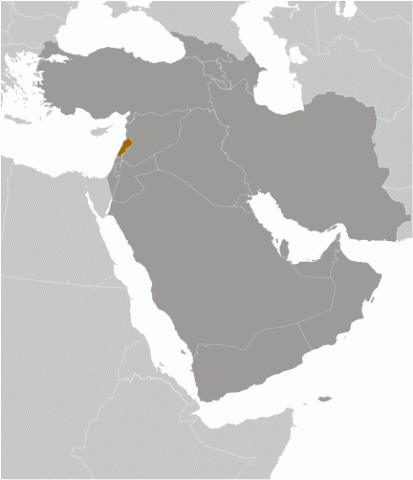Child Labor and Forced Labor Reports
Lebanon


Minimal Advancement
In 2024, Lebanon made minimal advancement in efforts to eliminate the worst forms of child labor. The government indicted 17 individuals on charges of human trafficking for exploiting approximately 30 victims using a social media platform in furtherance of child commercial sexual exploitation. It also established an Inter-Ministerial Committee on Trafficking in Persons. However, despite this effort, government officials continued to indicate that funding is insufficient to properly carry out their duties. In addition, Lebanese law prohibits inspectors from inspecting informal workplaces, where the majority of child labor occurs, and social programs targeting child labor remained insufficient to fully address the extent of the problem.
| Children | Age | Percent and Population |
|---|---|---|
| Working | 5 to 14 | Unavailable |
| Hazardous Work by Children | 15 to 17 | Unavailable |
| Attending School | 5 to 14 | Unavailable |
| Combining Work and School | 7 to 14 | Unavailable |
| Sector/Industry | Activity |
|---|---|
| Agriculture | Farming, including the production of potatoes and tobacco,† and fishing, sometimes with explosives.† |
| Industry | Construction,† including carpentry and welding,† working in slaughterhouses† and butcheries, and making handicrafts. Work in small garment factories. |
| Services | Street work,† including begging, street vending, portering, and scavenging garbage,† and collecting waste materials, including scrap metal. Use in protests, including burning tires. Working in small shops and groceries and in food service,† including working as waiters. Domestic work† and work in hair salons. Maintenance and repair of motor vehicles,† and driving tuk-tuks. |
| Categorical Worst Forms of Child Labor‡ | Use in illicit activities, including the production and trafficking of drugs and selling U.S. dollars and gasoline on the black market. Recruitment by non-state armed groups for use in armed conflict. Commercial sexual exploitation, sometimes as a result of human trafficking and sometimes virtually. Forced labor in agriculture and forced begging. |
† Determined by national law or regulation as hazardous and, as such, relevant to Article 3(d) of ILO C. 182.
‡ Child labor understood as the worst forms of child labor per se under Article 3(a)–(c) of ILO C. 182.
Children at Higher Risk
Non-Lebanese communities in Lebanon are particularly vulnerable to child labor. According to UN statistics, 22 percent of school-aged children, predominantly from Syria, but also from Iraq, Sudan, and other countries, were working rather than attending school in 2024. Also, during the reporting period, the percentage of children engaging in street work and retail has increased since 2023. Children, particularly Syrian children, are forced to beg throughout the country due to extreme poverty. Children involved in street begging are at increased vulnerability for further exploitation and abuse. Syrian children are also subjected to forced labor in agriculture, including in bonded labor alongside their families in the Bekaa Valley to pay for makeshift dwellings.
Barriers to Education Access
In 2024, the full or partial closures of 72 schools left 20,000 additional students without education in southern Lebanon due to increased hostilities with Israel. Prior to hostilities, 700,000 children in Lebanon already lacked access to schooling. Children face barriers to accessing education because of public sector strikes, which include teachers. In 2024, the government discontinued its policy of admitting all non-Lebanese children regardless of whether they had the required documentation for school enrollment. Over 44,000 children without valid resident documents or who were not registered with the UN Refugee Agency prior to 2015 were unable to attend school. Additionally, Syrian children face other difficulties, such as the cost of transportation and supplies, fear of passing checkpoints or of violence, lack of private sanitation facilities for girls, discrimination, and corporal punishment. Furthermore, most children with disabilities were unable to attend school due to insufficient accessibility or inadequacy of facilities.
| Standard | Age | Meets International Standards | Legislation |
|---|---|---|---|
| Minimum Age for Work | 14 | ✗ | Article 22 of the Labor Code |
| Minimum Age for Hazardous Work | 18 | ✓ | Articles 1 and 2 and Annex 2 of Decree No. 8987 |
| Identification of Hazardous Occupations or Activities Prohibited for Children | ✓ | Annex 1 of Decree No. 8987 | |
| Prohibition of Slavery, Debt Bondage, and Forced Labor | ✓ | Article 8 of Decree No. 3855; Articles 569, 586.1, and 586.5 of the Penal Code | |
| Prohibition of Child Trafficking | ✓ | Articles 586.1 and 586.5 of the Penal Code | |
| Prohibition of Commercial Sexual Exploitation of Children | ✓ | Articles 506, 523, 525–527, 586.1, and 586.5 of the Penal Code; Decree No. 8987 | |
| Prohibition of Using Children in Illicit Activities | ✓ | Articles 586.1, 586.5, and 618 of the Penal Code; Article 13 of the Law on Drugs | |
| Minimum Age for Voluntary State Military Recruitment | 18 | ✓ | Article 30 of the National Defense Law |
| Prohibition of Compulsory Recruitment of Children by (State) Military | N/A | ||
| Prohibition of Military Recruitment by Non-state Armed Groups | ✓ | Article 586.1 of the Penal Code; Annex 1 of Decree No. 8987 | |
| Compulsory Education Age | 15‡ | ✓ | Article 49 of the Education Law |
| Free Public Education | ✗ | Article 49 of the Education Law |
‡ Age calculated based on available information
The Labor Code applies only to workers who perform work in industrial, trading, or agricultural enterprises and excludes domestic work and non-industrial, non-trade agriculture. This does not conform to international standards that require all children to be protected by the minimum age for work. In addition, as the minimum age for work is lower than the compulsory education age, children may be encouraged to leave school before the completion of compulsory education. Lastly, while Lebanon’s laws provide for free basic education for citizens, they do not meet international standards because they do not cover non-citizen children.
| Organization/Agency | Role & Activities |
|---|
| Ministry of Labor: Enforces child labor laws through desk review and workplace inspections. The Ministry of Labor’s Child Labor Unit acts as the government focal point for child labor issues and raises public awareness about child labor and the right to education. Receives complaints of child labor violations on its Child Labor Unit hotline. Is only able to enforce labor laws in the formal sector, leaving children vulnerable to exploitation in the informal sector, such as in agriculture, small businesses, and private homes. |
| Internal Security Forces: Enforce laws regarding child labor through the Anti-Human Trafficking and Moral Crimes Unit. The Anti-Trafficking Unit is reportedly underfunded and understaffed. |
| Overview of Enforcement Efforts | 2024 |
|---|---|
| Has a Labor Inspectorate | Yes |
| Able to Assess Civil Penalties | No |
| Routinely Conducted Worksite Inspections | No |
| Unannounced Inspections Permitted | Yes |
| Has a Complaint Mechanism | Yes |
| Imposed Penalties for Child Labor Violations | Unknown |
| Conducted Criminal Investigations for Worst Forms of Child Labor Crimes | Yes |
| Imposed Penalties for Worst Forms of Child Labor Crimes | No |
It is unknown how many labor inspectors conducted worksite inspections, or whether child labor violations were found in 2024. It is unknown how many investigations into suspected cases of the worst forms of child labor were conducted, prosecutions were initiated, or perpetrators were convicted. In at least 1 case, the government indicted 17 individuals on charges, including human trafficking of approximately 30 victims for using a social media platform in furtherance of commercial sexual exploitation of children.
| Coordinating Body | Role & Activities |
|---|
| Inter-Ministerial Committee on Trafficking in Persons:* Established in 2024 to implement recommendations from the U.S. Department of State’s Trafficking in Persons Report. Includes representatives of relevant government ministries and civil society organizations. Held its first meeting on July 9. |
* Mechanism to coordinate efforts to address child labor was created during the reporting period.
| Policy | Description & Activities |
|---|
| National Action Plan to End Street Begging by Children: Seeks to end child begging by ensuring legal protection for street children, building capacity to protect street children, rehabilitating and reintegrating street children, and conducting outreach regarding the problem. Research was unable to determine whether activities were undertaken to implement the National Action Plan to End Street Begging by Children during the reporting period. |
| Work Plan to Prevent and Respond to the Association of Children with Armed Violence in Lebanon: Provides the policy framework for the prevention of children’s involvement in armed conflict. Research was unable to determine whether activities were undertaken to implement the Work Plan to Prevent and Respond to the Association of Children with Armed Violence in Lebanon during the reporting period. |
| Program | Description & Activities |
|---|
| UNICEF Programs: UNICEF implements several programs with the Ministry of Social Affairs to address child labor through interventions, including training government officials and others on children’s rights, training teachers, enrolling children with disabilities in schools, building and repairing schools, and other activities. Active in 2024. |
| Area | Suggested Action |
|---|---|
| Legal Framework | Accede to the UN Convention on the Rights of the Child Optional Protocol on Armed Conflict. |
| Raise the minimum age for work from 14 to 15 to align with the compulsory education age. | |
| Ensure that the minimum age for work applies to all children, including informal workers, domestic workers, and all agricultural workers. | |
| Enforcement | Track and publish information on labor law enforcement on an annual basis. |
| Authorize the labor inspectorate to conduct inspections in the informal sector. | |
| Ensure labor inspectors have a mechanism to assess civil penalties for child labor violations. | |
| Implement a digital tracking system for civil worst forms of child labor inspections. | |
| Employ at least 129 labor inspectors to ensure adequate coverage of the labor force of approximately 1.9 million people, provide the Ministry of Labor inspectors with proper funding and resources, and ensure that routine inspections are carried out. | |
| Publish information on the number of prosecutions initiated and the number of convictions for violations of criminal laws. | |
| Ensure that criminal law enforcement agencies, including the Internal Security Forces’ Anti-Human Trafficking Unit, have the necessary funding and staff to investigate and prosecute criminal cases of child labor in accordance with the law. | |
| Coordination | Ensure that the National Steering Committee on Child Labor meets on a regular basis and coordinates activities to address child labor. |
| Government Policies | Ensure that activities are undertaken to implement the National Action Plan to End Street Begging by Children and the Work Plan to Prevent and Respond to the Association of Children with Armed Violence in Lebanon during the reporting period and that data on these activities are published on an annual basis. |
| Adopt a policy that addresses all relevant worst forms of child labor. | |
| Social Programs | Collect and publish data on the extent and nature of child labor to inform policies and programs. |
| Ensure access to public education for all children, including refugees, improving transportation, addressing harassment, accommodating students with disabilities, ending corporal punishment, improving facilities, and accommodating students coming from a different curriculum from that in Lebanon. | |
| Expand programs, including social services for human trafficking survivors, to fully address the extent of child labor, including in construction and forced labor in agriculture. |



